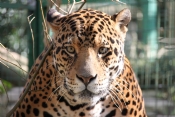Jaguars
Ares

Park: |
Wildlife Heritage Foundation (WHF) |
Species: |
Jaguar (Panthera Onca) |
Age: |
Coming soon... |
Sex: |
Male |
Info: |
Unlike many other big cats, apart from man, the jaguar has no rivals - no other predator can compete with this powerful cat. The jaguarís main periods of hunting activity are greatly dependent upon location - in some areas which are close to human habitation it appears that the cat is most active at night, whilst in other locations the jaguar is crepuscular and in certain cases diurnal in its hunting activity. The prey base of the jaguar is extensive, taking full advantage of the diversity and dense concentration of animal species found in the rainforest areas. In size its prey ranges from large domestic livestock such as cattle and horses (for which it has a poor reputation with local farmers), Marsh deer, Brocket deer, down through various species of Peccary, larger rodents such as Capybara, Paca and Agouti, to reptiles, monkeys and fish. In comparison with the other cats of its size the jaguar has particularly power jaws and often kills its prey by piercing the skull with one swift bite. In the Cockscomb Basin Reserve in Belize the predominant prey species has been found to be Armadillo, whos bony protective plates offer little defence against the power of the jaguars bite. Where possible, the cat will inhabit areas close to water - it is an expert in catching fish and will often tackle turtles and large caiman, dragging them from the water to hide the carcass in the dense undergrowth. Equally at home as a climber, although not as adept as the leopard, the jaguar will hunt monkeys in the lower branches of the large rain forest trees. In much of its range where man lives close by, the jaguar now has to compete with the human hunter and poacher who take many of the same species as the big cat. During the peak of its decline in the sixties and seventies, around 18,000 jaguars were killed every year for there much sought after coat. Due to environmental pressure the fashion for animal furs has declined, but the jaguar is still hunted. Today the major threat comes from deforestation which is drastically affecting the jaguars prey base as well as fragmenting the catís population into more isolated pockets. |
Gallery: |
© 2013 EarthZoo | EarthZoo (UK) / Earthzoo (Namibia)
